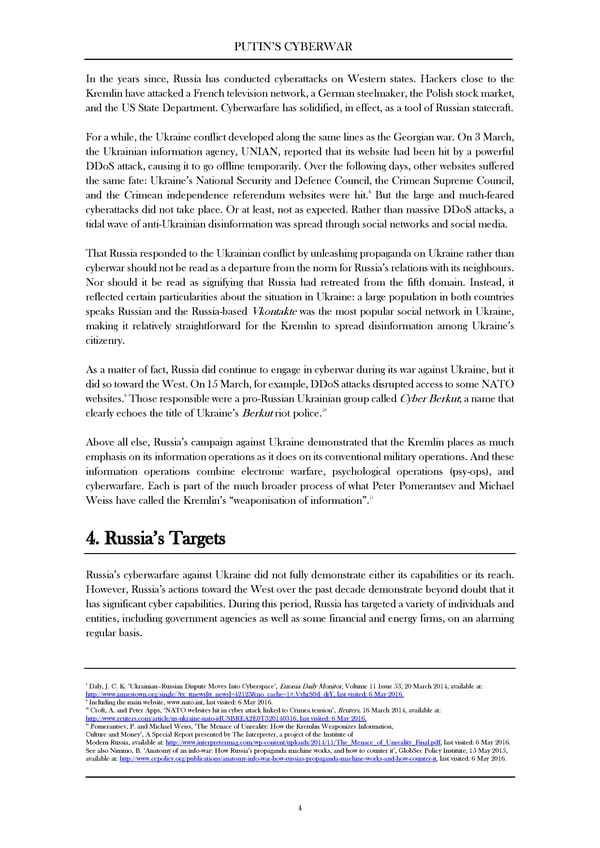PUTIN’S CYBERWAR In the years since, Russia has conducted cyberattacks on Western states. Hackers close to the Kremlin have attacked a French television network, a German steelmaker, the Polish stock market, and the US State Department. Cyberwarfare has solidified, in effect, as a tool of Russian statecraft. For a while, the Ukraine conflict developed along the same lines as the Georgian war. On 3 March, the Ukrainian information agency, UNIAN, reported that its website had been hit by a powerful DDoS attack, causing it to go offline temporarily. Over the following days, other websites suffered the same fate: Ukraine’s National Security and Defence Council, the Crimean Supreme Council, and the Crimean independence referendum websites were hit.8 But the large and much-feared cyberattacks did not take place. Or at least, not as expected. Rather than massive DDoS attacks, a tidal wave of anti-Ukrainian disinformation was spread through social networks and social media. That Russia responded to the Ukrainian conflict by unleashing propaganda on Ukraine rather than cyberwar should not be read as a departure from the norm for Russia’s relations with its neighbours. Nor should it be read as signifying that Russia had retreated from the fifth domain. Instead, it reflected certain particularities about the situation in Ukraine: a large population in both countries speaks Russian and the Russia-based Vkontakte was the most popular social network in Ukraine, making it relatively straightforward for the Kremlin to spread disinformation among Ukraine’s citizenry. As a matter of fact, Russia did continue to engage in cyberwar during its war against Ukraine, but it did so toward the West. On 15 March, for example, DDoS attacks disrupted access to some NATO 9 websites. Those responsible were a pro-Russian Ukrainian group called Cyber Berkut; a name that 10 clearly echoes the title of Ukraine’s Berkut riot police. Above all else, Russia’s campaign against Ukraine demonstrated that the Kremlin places as much emphasis on its information operations as it does on its conventional military operations. And these information operations combine electronic warfare, psychological operations (psy-ops), and cyberwarfare. Each is part of the much broader process of what Peter Pomerantsev and Michael 11 Weiss have called the Kremlin’s “weaponisation of information”. 4. Russia’s Targets Russia’s cyberwarfare against Ukraine did not fully demonstrate either its capabilities or its reach. However, Russia’s actions toward the West over the past decade demonstrate beyond doubt that it has significant cyber capabilities. During this period, Russia has targeted a variety of individuals and entities, including government agencies as well as some financial and energy firms, on an alarming regular basis. 8 Daly, J. C. K. ‘Ukrainian–Russian Dispute Moves Into Cyberspace’, Eurasia Daily Monitor, Volume 11 Issue 53, 20 March 2014, available at: http://www.jamestown.org/single/?tx_ttnews[tt_news]=42123&no_cache=1#.VyhrS0d_diY, last visited: 6 May 2016. 9 Including the main website, www.nato.int, last visited: 6 May 2016. 10 Croft, A. and Peter Apps, ‘NATO websites hit in cyber attack linked to Crimea tension’, Reuters, 16 March 2014, available at: http://www.reuters.com/article/us-ukraine-nato-idUSBREA2E0T320140316, last visited: 6 May 2016. 11 Pomerantsev, P. and Michael Weiss, ‘The Menace of Unreality: How the Kremlin Weaponizes Information, Culture and Money’, A Special Report presented by The Interpreter, a project of the Institute of Modern Russia, available at: http://www.interpretermag.com/wp-content/uploads/2014/11/The_Menace_of_Unreality_Final.pdf, last visited: 6 May 2016. See also Nimmo, B. ‘Anatomy of an info-war: How Russia’s propaganda machine works, and how to counter it’, GlobSec Policy Institute, 15 May 2015, available at: http://www.cepolicy.org/publications/anatomy-info-war-how-russias-propaganda-machine-works-and-how-counter-it, last visited: 6 May 2016. 4
 Putin's Cyberwar Page 6 Page 8
Putin's Cyberwar Page 6 Page 8